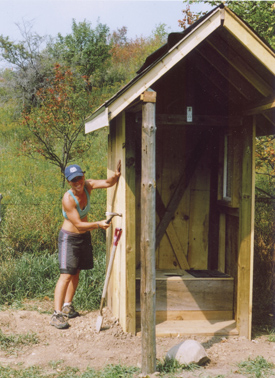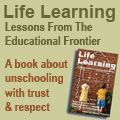Learning to Build
By Nathalie Zur Nedden
A self-taught builder mentors other women as they learn skills and independence, and encourages them to expose their children to the same self-reliance.
 After years of being tired of not feeling confident enough to use a drill or an electric saw, I recently attended a full-day workshop held at a tools store, entitled “Women and Power Tools.” I had no idea of what to expect or of what I was about to learn. When I entered the store I must have had an inexperienced look on my face because the salesclerk directed me immediately to the seminar room; she knew I wasn’t there to buy tools! The seminar room was set-up with tables and stools, and there were pictures mounted on a white-board. One set of pictures consisted of a beautiful humidor and a large wall cabinet with a caption that read, “Betty built this.” The other set of pictures were of a woman sitting on a house frame and the second photo was of a small, beautiful cabin with a caption that read, “Jen built this.” “When do I get to build that?” I asked pointing to the photograph of the cabin. “That’s power tools III,” Jen, our instructor, answered smiling. After years of being tired of not feeling confident enough to use a drill or an electric saw, I recently attended a full-day workshop held at a tools store, entitled “Women and Power Tools.” I had no idea of what to expect or of what I was about to learn. When I entered the store I must have had an inexperienced look on my face because the salesclerk directed me immediately to the seminar room; she knew I wasn’t there to buy tools! The seminar room was set-up with tables and stools, and there were pictures mounted on a white-board. One set of pictures consisted of a beautiful humidor and a large wall cabinet with a caption that read, “Betty built this.” The other set of pictures were of a woman sitting on a house frame and the second photo was of a small, beautiful cabin with a caption that read, “Jen built this.” “When do I get to build that?” I asked pointing to the photograph of the cabin. “That’s power tools III,” Jen, our instructor, answered smiling.
“Today you are going to learn how to use a miter saw, a table saw, a drill press, a jigsaw, a band saw, a router, a circular saw, and a router table. By the end of the day, with the help of these tools, you will each leave here with a toolbox,” Jennifer said to the twelve women sitting in front of her. I whispered to my friend, “What the heck is a router?” “I don’t know,” she whispered back. After we were briefed on safety issues and apparel, Jennifer guided us to a large, high-ceiling room with twelve workstations, each armed with a different power tool, most of which I didn’t recognize.
When five o’clock rolled around, I couldn’t believe that I was leaving with a wooden toolbox that I had made using all the tools. What an exhilarating feeling; I experienced such a sense of empowerment. Why am I writing about this? Because when Jennifer introduced herself she informed us that she was self-taught. She is a terrific example of a self-directed life-long learner and I wanted to hear more of her story, and to share it with you. I think part of the deschooling process we engage in necessitates re-skilling ourselves. And the safe use of power tools is a valuable skill for anyone to have. So the next day, Jennifer graciously consented to an interview.
N: Thanks again, Jen, for such a great workshop yesterday. So how did you get involved with power tools?
J: I got interested in power tools fifteen years ago when I was married and we had country property. We were building a big storage shed and I wanted to help and to understand why and how things were done. And so I would constantly ask my husband, “Why do you do that?” I was like a child. I kept asking questions to the point where he got angry. I think he felt I was second-guessing him but I just wanted to understand. That was probably the beginning of my interest. We eventually separated and he took the place in the country and I got the house in the city. When you live in a house, there are always things that need to be done. I had gained some knowledge from passing the tools, holding the wood, watching and observing, and I thought, “I have to try this. I’m here alone and I can’t afford to pay anyone; I’m going to try fixing things first and if I can’t do it then I’ll hire someone.”
N: How did you get from fifteen years ago to what you do now, to be a contractor?
J: I found out that it wasn’t as hard as I thought it would be. I was doing well and realized it was a luxury to work on your own home because if you mess it up there is no one to see; so I learned on my own home. As people saw I could do this they said, “Hey Jen, can you come over and help me do this?” That’s certainly where I gained more interest; the jobs started to get bigger and bigger. The next step was starting to charge and deciding if that’s what I wanted to do. At the time I was a sign painter. I had had enough of that and I quit after fifteen years and thought, “Okay, I’ve gathered some tools, there’s work out there, and I feel confident with my knowledge and skillset. I’m going to give it a whirl.” My partner had a job, so I had that to fall back on, which was nice. I just went for it.
N: Why do you think women may initially be intimidated by the idea of building?
J: Because that’s what we’re led to believe. Building is a male domain, and while that is slowly changing, there certainly aren’t a lot of female role models as of yet. Chances are you won’t walk by a construction site and see a woman swinging a hammer. Women see this, so when it comes to building we are intimidated before we even start. What I tell women is that anyone can do woodworking, building, and repairing; the only difference between men and women is sometimes the strength factor.
N: Did you ever consider taking formal courses?
J: Not in woodworking, but I did take a one-year sign painting course at a college. That was about twenty-two years ago. I worked for someone for six months and then started my own business. I did that for fifteen years.
N: Do you feel there were any differences between the kind of learning you did on your own and the learning in a structured environment?
J: In fairness, when I started teaching this workshop I felt I should take a beginner woodworking course for comparison. I stayed for a few weeks and it didn’t impress me at all. I saw so much lacking in the course, like safety. There was never an introduction to tools; there was never an overall this-is-what-we’re-going-to-build part. I suppose the instructor assumed people should know this. At that time when I took the course I knew a fair amount, but I didn’t know how to use a hand-plane, and I certainly didn’t understand it any better after the instructor spent ten minutes on it. He thought we should know how to adjust it, how to use it and what it’s used for. The course was very dissatisfying for me and I thought that if that was what formal learning was about, I opted to continue learning on my own. When you have to pay rent and support yourself, the money you set aside for schooling is precious. It isn’t good if that money is being wasted.
N: What were some of the best strategies that assisted your learning?
J: I asked a lot of questions of anyone I could find and trust. Here’s a person who knows what I want to know; I’m just going to ask, and ask and ask, until they say, “Okay, you can’t ask anymore.” I learned from men.
N: Did you meet women mentors?
J: Not really.
N: Are you stepping into that role, then?
J: I suppose. When a friend asks me to change all the light fixtures in her house, what I do is show her how. For example, I go over to her house with the appropriate tools. I change a light fixture as she watches. Next, she changes a light fixture while I watch, and after that she’s on her own. Okay that’s not entirely true, I leave my tools – that’s one less expense, and I let her know that she can call me if she’s unsure or runs into a problem.
N: What’s the one thing that stands out for you in helping women learn?
J: I’m always amazed at women’s ability to help each other. We laugh and make jokes about the buddy system but it’s so great to see how women help one another out all day. I think it’s a “woman thing” because they know what it feels like to be in that situation and they make sure to help the person they’ve been asked to help. One of things I love most about teaching women is their realization that they can do it. I explain the correct way to use the tool, have them do a supervised cut, and then stand back and watch as they come to the realization that, “Hey, this isn’t as hard as I thought it would be. I can do this.” And often they can provide guidance to a group that hasn’t tried.
N: If you could create a full-day workshop, what would it look like? What would you consider the essential skills for a woman to learn?
J: Great question! Woodworking is a luxury. So I would set up a workshop that would revolve around a house – plumbing and electricity, little jobs like a leaking toilet, dripping faucet. Do you know how many people live with leaking taps? It’s easy to fix once you know how. Another course I would love to offer is car mechanics 101 – changing oil, tires, check the fluids, change wipers, getting under the car and learning about the muffler. When a mechanic tells me it’s my right ball joint, I know what he’s talking about. I can talk the talk back.
N: Got any advice for women?
J: Woodworking and repairing isn’t that hard; expose your children to it as soon as you feel they’re ready for it. Knowledge is power and so is having these skills. If you have the opportunity to have someone show you something, try to do it, then help your kids learn it. Being at home, independent and having this knowledge is a great foundation for women. Try to take care of your own home so you don’t have to rely on others that you pay; it’s empowering.
Nathalie Zur Nedden left her home in Montréal, Québec and quit school at the age of thirteen. She has been learning ever since, both through life experiences and university. Her work with at-risk youth eventually led her to a Master of Arts in Transformative Learning from the Ontario Institute for Studies in Education at the University of Toronto and a Ph.D. based on telling the story of a Canadian woman who has theorized about the virtues of alternatives to formal schooling – Life Learning’s editor Wendy Priesnitz.
Copyright © Life Media
Privacy Policy
  
  

|

